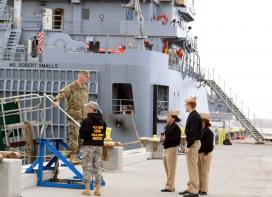The Army Goes "Sailing" Along - Army Leaders Introduce Midshipmen to Career Opportunities
KINGS POINT, N.Y., Dec. 10, 2015 – Two U.S. Army Reserve vessels arrived at the United States Merchant Marine Academy (USMMA) and tied up at Mallory Pier last month. Over several days, U. S. Army Reserve leaders met with midshipmen and introduced them to the obligation-fulfilling career opportunities that are available to them as reservists aboard Army watercraft.
Midshipmen enjoyed tours given by the Warrant Officers and enlisted mariners aboard Logistics Support Vessel (LSV) Maj. Gen. Robert Smalls, operated by the 203rd Transportation Detachment, and Large Tug (LT) Major General Anthony Wayne, operated by the 949th Transportation Company, both out of Baltimore, MD.
“Having the Army Vessels visit the Academy was a great opportunity to see what kind of vessels the Army actually has. It showed us an opportunity that many people do not know about” said Regimental Training Vessel Master and Intercollegiate Sailing Team Captain, Midshipman 1st Class Austin Neuman.
This sentiment was echoed by Regimental Training Vessel Chief Mate, Midshipmen 1st Class Rexford Ryman, “As a midshipman who has not spent any time on the bridge of a military vessel, rather all my time on commercial ships, it was interesting to see the similarities and differences of the Army’s LSV versus a commercial vessel. The Bridge equipment aboard, is a near mirror replica to USMMA’s Full Mission Bridge Simulator that we use in class.”
The vessels’ crew lists contained many members of the USMMA community; including Chief Warrant Officer Kevin Clarke, (SUNY Maritime ’85) ,USMMA’s Director of Information Technology, Chief Warrant Officer John Lutz (USMMA ’92), USMMA Professor of Marine Transportation and Chief Warrant Officer Anthony Esposito (USMMA ’10). On other assignments were Chief Warrant Officer Michael Plocharczyk (USMMA ’10), Chief Warrant Officer Hunter Eakins (USMMA ’12), and Chief Warrant Officer James Gurney (USMMA ’12).
Two U.S. Army Reserve generals, Army Deputy G-1 and Chairman Army Reserve Forces Policy Committee, Maj. Gen. William Waff, and the commanding general for the 200th Military Police Command, Maj. Gen. Phillip Churn generously answered questions about the Watercraft Program.
“There are only a limited number of active duty Navy slots open to every graduating class”, said Churn. He wants midshipmen to be aware “that the Army Reserve also conducts maritime operations.”
The Army Marine Deck Warrant Officer and Marine Engineering Warrant Officer military occupational specialties allow licensed USMMA graduates to serve in the Army Watercraft field and meet their service obligation. Only Warrant Officers and enlisted soldiers serve aboard US Army watercraft. As Soldier Mariners, graduates can sail on commercial vessels honing the skills that are beneficial to both their maritime and Army Reserve careers.
Waterborne logistics delivers 90 percent of all unit equipment and supplies of U.S. forces. Army watercraft provide the critical link between offshore arrival of combat power loaded aboard strategic sealift ships and placing that power ashore in a ready-to-fight configuration. Army watercraft are prepared to deploy at any time, to any location to support their mission.
Army watercraft fall into two categories, lighterage and floating utility. These two categories are defined according to the mission they perform. Lighterage are craft used to transport equipment, cargo and personnel between ships, from ship-to-shore or for intra-theater transport. Lighterage are further classified into conventional displacement (landing craft), amphibious (wheeled), or modular causeway systems (powered ferry). Floating Utility craft perform operations incidental to water terminal operations, except lighterage service. Watercraft in this category are harbor and ocean going tugs, pusher tugs, floating cranes, barges, floating machine shops, floating causeway and Roll-On/Roll-Off (RO/RO) discharge facilities (RRDF).
Army Capt. Nelson Suero, USMMA Army Liaison, said “Kings Pointers have both the academic and the practical skill-set the Watercraft program is looking for in a newly appointed officer.”
At graduation, each USMMA graduate receives a Bachelor of Science degree, a United States Coast Guard License as a Deck Officer or Engineer, and an officer commission in any branch of the U.S. Military. As part of their service obligation each graduate serves Active Duty for five years or as a reservist for 8 years while sailing as an Officer in the U.S. Merchant Marine.
Suero said that his leadership was very pleased by the visit and are already working on their next trip to Kings Point.
More photos at: U.S. Army Visit to USMMA
By Veronica Cassidy Barry
